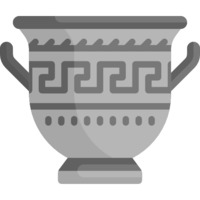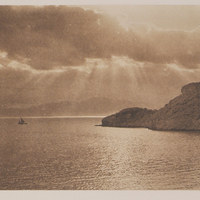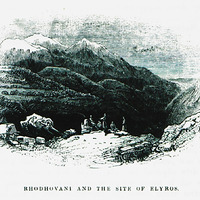Ροδοβάνι (Έλυρος)
Αντικείμενο
Τίτλος Σημείου Ενδιαφέροντος
el
Ροδοβάνι (Έλυρος)
en
Rodovani
Περιγραφή / Απόσπασμα
140-145
en
After a slight survey of these remains we pro ceed to the village of Rhodhovani, about half a mile farther on. The chief fountain in this village is a very copious source, surrounded as usual by lofty trees, and occupied, at the moment of our arrival, by seven or eight Greek women, employed in washing their linen.
Παρατηρήσεις
el
Ο γραμματικός του χωρίου, μετά την περιήγηση στην Έλυρο, του προσφέρει μέλι. Η ποιότητα του μελιού οδηγεί τον Pashley να σκεφτεί ότι αυτός ήταν πιθανότατα και ο λόγος που τα νομίσματα της αρχαίας πόλης απεικόνιζαν τη μέλισσα.
en
The grammarian of the village, after the tour in Elyros, offers him honey. The quality of the honey leads Pashley to think that this was probably the reason why the coins of the ancient city depicted the bee.
Σύγχρονη περιγραφή
el
Η αρχαία πόλη Έλυρος είναι κτισμένη επάνω στον λόφο Κεφάλα κοντά στο χωριό Ροδοβάνι. Θεωρείται η σημαντικότερη αρχαία πόλη στη νοτιοδυτική Κρήτη κατά τους ελληνιστικούς και ρωμαϊκούς χρόνους. Λιμάνια της ήταν η Συία και η Λισσός. Σύμφωνα με την παράδοση, στην Έλυρο τιμούσαν ιδιαίτερα τον Απόλλωνα, ο οποίος απέκτησε με τη νύμφη Ακακαλλίδα τους δίδυμους γιούς Φυλακίδη και Φίλανδρο, που τους θήλασε μια κατσίκα. Έτσι, οι Ελύριοι αφιέρωσαν στους Δελφούς ένα χάλκινο σύμπλεγμα, με μία αίγα να θηλάζει τα δύο νήπια. Από την Έλυρο λέγεται ότι καταγόταν ο λυρικός ποιητής Θαλήτας.
Ανεξάρτητη και αυτόνομη η πόλη, είχε κόψει δικό της νόμισμα και κατά τους ελληνιστικούς χρόνους υπήρξε μέλος της «Ομοσπονδίας των Ορείων», μαζί με τις πόλεις Υρτακίνα, Λισό, Ποικιλασσό και Τάρρα. Η ΄Ελυρος διατήρησε τη δραστηριότητά της και κατά την Α΄ Βυζαντινή περίοδο οπότε και υπήρξε έδρα Επισκοπής, μέχρι που καταστράφηκε από τους Σαρακηνούς και εγκαταλείφθηκε.
Ο Robert Pashley ήταν ο πρώτος που αναγνώρισε τη θέση της πόλης, ενώ ο Thenon ήταν αυτός που επιβεβαίωσε τον Pashley, όταν αργότερα ανακάλυψε την επιγραφή που έγραφε «έδοξε τη πόλει των Ελυρίων». Στο χώρο της αρχαίας πόλης διακρίνονται ερείπια κτηρίων, από τα οποία σώζονται οι εντυπωσιακές υδατοδεξαμενές, τμήματα του ρωμαϊκού υδραγωγείου, του αρχαίου τείχους και του αρχαίου θεάτρου και ο τούρκικος«κουλές», στην κορυφή του υψώματος. Επίσης, γύρω από την πόλη εκτείνεται και το νεκροταφείο.
Στο κέντρο του αρχαιολογικού χώρου υπάρχει η εκκλησία της Παναγίας, κτισμένη πάνω στα ερείπια μίας Παλαιοχριστιανικής βασιλικής, από την οποία σώζονται ψηφιδωτά δάπεδα. Τέλος, εντυπωσιακό είναι και το άγαλμα των ρωμαϊκών χρόνων, ο επονομαζόμενος «Φιλόσοφος της Ελύρου», που σήμερα εκτίθεται στο Αρχαιολογικό Μουσείο Χανίων.
Ανεξάρτητη και αυτόνομη η πόλη, είχε κόψει δικό της νόμισμα και κατά τους ελληνιστικούς χρόνους υπήρξε μέλος της «Ομοσπονδίας των Ορείων», μαζί με τις πόλεις Υρτακίνα, Λισό, Ποικιλασσό και Τάρρα. Η ΄Ελυρος διατήρησε τη δραστηριότητά της και κατά την Α΄ Βυζαντινή περίοδο οπότε και υπήρξε έδρα Επισκοπής, μέχρι που καταστράφηκε από τους Σαρακηνούς και εγκαταλείφθηκε.
Ο Robert Pashley ήταν ο πρώτος που αναγνώρισε τη θέση της πόλης, ενώ ο Thenon ήταν αυτός που επιβεβαίωσε τον Pashley, όταν αργότερα ανακάλυψε την επιγραφή που έγραφε «έδοξε τη πόλει των Ελυρίων». Στο χώρο της αρχαίας πόλης διακρίνονται ερείπια κτηρίων, από τα οποία σώζονται οι εντυπωσιακές υδατοδεξαμενές, τμήματα του ρωμαϊκού υδραγωγείου, του αρχαίου τείχους και του αρχαίου θεάτρου και ο τούρκικος«κουλές», στην κορυφή του υψώματος. Επίσης, γύρω από την πόλη εκτείνεται και το νεκροταφείο.
Στο κέντρο του αρχαιολογικού χώρου υπάρχει η εκκλησία της Παναγίας, κτισμένη πάνω στα ερείπια μίας Παλαιοχριστιανικής βασιλικής, από την οποία σώζονται ψηφιδωτά δάπεδα. Τέλος, εντυπωσιακό είναι και το άγαλμα των ρωμαϊκών χρόνων, ο επονομαζόμενος «Φιλόσοφος της Ελύρου», που σήμερα εκτίθεται στο Αρχαιολογικό Μουσείο Χανίων.
en
The ancient city of Elyros is built upon the hill Kefala, near the village Rodovani. It is considered to be the most important ancient city in southwestern Crete, in the Hellenistic and Roman era. Its ports were Syia and Lissos. According to tradition, in Elyros, they used to honor Apollo in particular, who had two twin sons with nymph Acaccalid, Fylakidis and Filandros, who were breastfed by a goat. Thus, the Elyrians dedicated to Delphi a copper complex, with a goat breastfeeding the two toddlers. It is said that the lyrical poet Thaletas was originally from Elyros.
This city was independent and autonomous, it minted its own coin and in Hellenistic times it was a member of the “Confederation of the Oreians”, together with the cities Yrtakina, Lissos, Poikilassos and Tarrha. Elyros remained active also during the 1st Byzantine period, when it was a seat for the Diocese, up until it was destroyed by the Saracens and was abandoned.
Robert Pashley was the first that discovered the position of the city, while Thenon was the one that confirmed Pashley, when he later discovered the inscription that said “glory to the city of Elyrians”. In the site of the ancient city one can see ruins of buildings, of which the impressive water tanks are preserved, parts of the Roman aqueduct, of the ancient walls and the ancient theater, as well as the Turkish “koule”, at the top of the hill. Also, around the city, the graveyard extends.
At the center of the archaeological site there is the church of the Virgin Mary, built on the ruins of an early Christian basilica, of which mosaic floors are preserved. A statue dating from Roman times, called “the Philosopher of Elyros” is also impressive, and is exhibited today at the Archaeological Museum of Hania.
This city was independent and autonomous, it minted its own coin and in Hellenistic times it was a member of the “Confederation of the Oreians”, together with the cities Yrtakina, Lissos, Poikilassos and Tarrha. Elyros remained active also during the 1st Byzantine period, when it was a seat for the Diocese, up until it was destroyed by the Saracens and was abandoned.
Robert Pashley was the first that discovered the position of the city, while Thenon was the one that confirmed Pashley, when he later discovered the inscription that said “glory to the city of Elyrians”. In the site of the ancient city one can see ruins of buildings, of which the impressive water tanks are preserved, parts of the Roman aqueduct, of the ancient walls and the ancient theater, as well as the Turkish “koule”, at the top of the hill. Also, around the city, the graveyard extends.
At the center of the archaeological site there is the church of the Virgin Mary, built on the ruins of an early Christian basilica, of which mosaic floors are preserved. A statue dating from Roman times, called “the Philosopher of Elyros” is also impressive, and is exhibited today at the Archaeological Museum of Hania.




